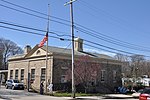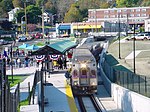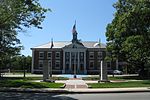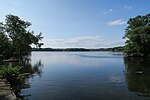Pond Meadow Park
1976 establishments in MassachusettsGeography of Braintree, MassachusettsMassachusetts geography stubsNorfolk County, Massachusetts geography stubsNortheastern United States protected area stubs ... and 3 more
Parks in Norfolk County, MassachusettsProtected areas established in 1976Weymouth, Massachusetts
Pond Meadow Park is a 320 acres (130 ha) multi use park located between the towns of Braintree and Weymouth in Massachusetts. It has a 20 acres (8.1 ha) pond and dam that provide floodplain protection to the nearby Weymouth Landing Area. The park also acts as a recreation and conservation area, with a picnic area, camp ground, and walking and bike trails. It was officially opened in 1976 and is run under the Weymouth Braintree Regional Recreation Conservation District.
Excerpt from the Wikipedia article Pond Meadow Park (License: CC BY-SA 3.0, Authors).Pond Meadow Park
Liberty Street,
Geographical coordinates (GPS) Address Nearby Places Show on map
Geographical coordinates (GPS)
| Latitude | Longitude |
|---|---|
| N 42.2048 ° | E -70.9826 ° |
Address
Liberty Street 470
02184
Massachusetts, United States
Open on Google Maps










